Managing a Successful Business Project
22 Pages7038 Words60 Views
Added on 2022-12-27
About This Document
This document provides insights into managing a successful business project and the impact of retention practices on employee performance. It discusses the case of John Lewis Partnership and provides recommendations for employee retention.
Managing a Successful Business Project
Added on 2022-12-27
ShareRelated Documents
Managing a successful
business project
1
business project
1

Table of Contents
Chapter1 INTRODUCTION............................................................................................................3
Background of a company......................................................................................................3
Aim and Objectives................................................................................................................3
Rationale of the project..........................................................................................................4
Chapter 2 LITERATURE REVIEW................................................................................................5
Various retention practices within an organisation................................................................5
Impact of retention practices on the performance of John Lewis Partnership.......................6
Recommending ways through which John Lewis Partnership can retain employees for longer
time period..............................................................................................................................7
Chapter 3 RESEARCH METHODOLOGY....................................................................................9
Chapter 4 RESULTS......................................................................................................................12
Chapter 5 Conclusions and Recommendations..............................................................................18
Chapter 6 REFLECTION..............................................................................................................19
REFERENCES..............................................................................................................................21
Appendix........................................................................................................................................23
Interview for manager..........................................................................................................23
Interview for employees.......................................................................................................23
2
Chapter1 INTRODUCTION............................................................................................................3
Background of a company......................................................................................................3
Aim and Objectives................................................................................................................3
Rationale of the project..........................................................................................................4
Chapter 2 LITERATURE REVIEW................................................................................................5
Various retention practices within an organisation................................................................5
Impact of retention practices on the performance of John Lewis Partnership.......................6
Recommending ways through which John Lewis Partnership can retain employees for longer
time period..............................................................................................................................7
Chapter 3 RESEARCH METHODOLOGY....................................................................................9
Chapter 4 RESULTS......................................................................................................................12
Chapter 5 Conclusions and Recommendations..............................................................................18
Chapter 6 REFLECTION..............................................................................................................19
REFERENCES..............................................................................................................................21
Appendix........................................................................................................................................23
Interview for manager..........................................................................................................23
Interview for employees.......................................................................................................23
2
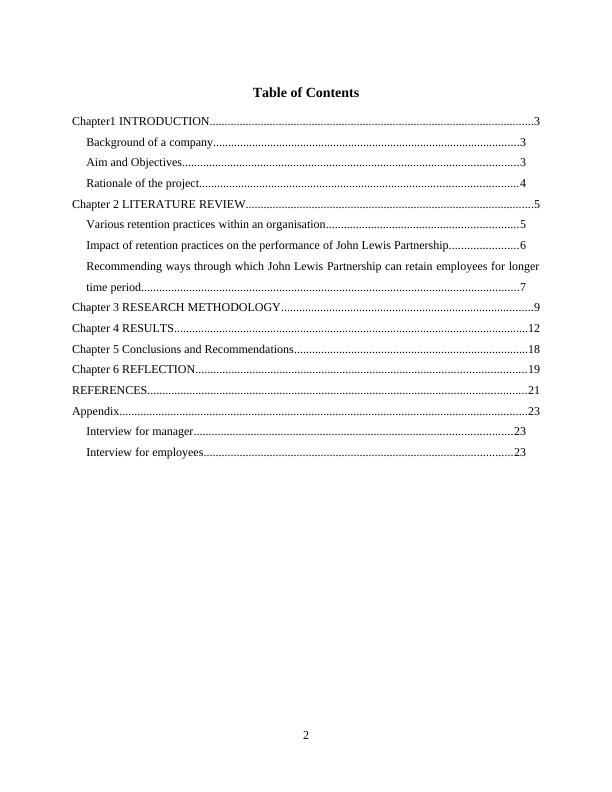
Chapter1 INTRODUCTION
Talent management is defined as the process by which organisations search, recruit,
select, motivate and develop employees. The main reason of forming talent management is
creating workforce who is always motivated to work towards the achievement of business goals
and aims. Talent management focuses on meeting every need of employees with the attainment
of objectives and targets (Khalid and Nawab, 2018). Talent managed is formed to improve the
performances of organisations or businesses by acquiring qualified candidates, it makes
companies to remain competitive in the market by developing existing employees and recruiting
new employees with advanced skills and talent, it supports tools, technologies and techniques
that are used by employees who are selected by them, these employees use technologies in such
a way so that an organisation gets maximum benefits and advantages (MICHAEL, PRINCE and
CHACKO, 2016). The current project would discuss about the concept of talent management
and it various practices used for retaining employees employees in John Lewis. With this it also
discusses about the impact of talent management practices on employee retention.
Background of a company
John Lewis Partnership is a company which operates departmental stores of John Lewis
and partners, supermarkets of Wait rose and Partners, services related to banks and financial
institutions and other activities related to retail. The company is a retail industry founded in
London, 1929 by John Spedan Lewis. Trust has owned John Lewis Partnership on behalf of its
workforce called as partners. In Sunday Times it is mentioned that John Lewis Partnership has
secured third largest place in non traded company of UK in 2016. The company focuses on
providing goods and services to the upper and middle class level of population. It deals in
products like furniture, computing, photography, fashion accessories, clothing and many more. It
has employees over 83000.
Aim and Objectives
Aim of the project
“To examine the effectiveness of employee retention practices at JLP.” A study on John Lewis
Partnership
Objectives of the project
To understand the various retention practices within an organisation.
3
Talent management is defined as the process by which organisations search, recruit,
select, motivate and develop employees. The main reason of forming talent management is
creating workforce who is always motivated to work towards the achievement of business goals
and aims. Talent management focuses on meeting every need of employees with the attainment
of objectives and targets (Khalid and Nawab, 2018). Talent managed is formed to improve the
performances of organisations or businesses by acquiring qualified candidates, it makes
companies to remain competitive in the market by developing existing employees and recruiting
new employees with advanced skills and talent, it supports tools, technologies and techniques
that are used by employees who are selected by them, these employees use technologies in such
a way so that an organisation gets maximum benefits and advantages (MICHAEL, PRINCE and
CHACKO, 2016). The current project would discuss about the concept of talent management
and it various practices used for retaining employees employees in John Lewis. With this it also
discusses about the impact of talent management practices on employee retention.
Background of a company
John Lewis Partnership is a company which operates departmental stores of John Lewis
and partners, supermarkets of Wait rose and Partners, services related to banks and financial
institutions and other activities related to retail. The company is a retail industry founded in
London, 1929 by John Spedan Lewis. Trust has owned John Lewis Partnership on behalf of its
workforce called as partners. In Sunday Times it is mentioned that John Lewis Partnership has
secured third largest place in non traded company of UK in 2016. The company focuses on
providing goods and services to the upper and middle class level of population. It deals in
products like furniture, computing, photography, fashion accessories, clothing and many more. It
has employees over 83000.
Aim and Objectives
Aim of the project
“To examine the effectiveness of employee retention practices at JLP.” A study on John Lewis
Partnership
Objectives of the project
To understand the various retention practices within an organisation.
3
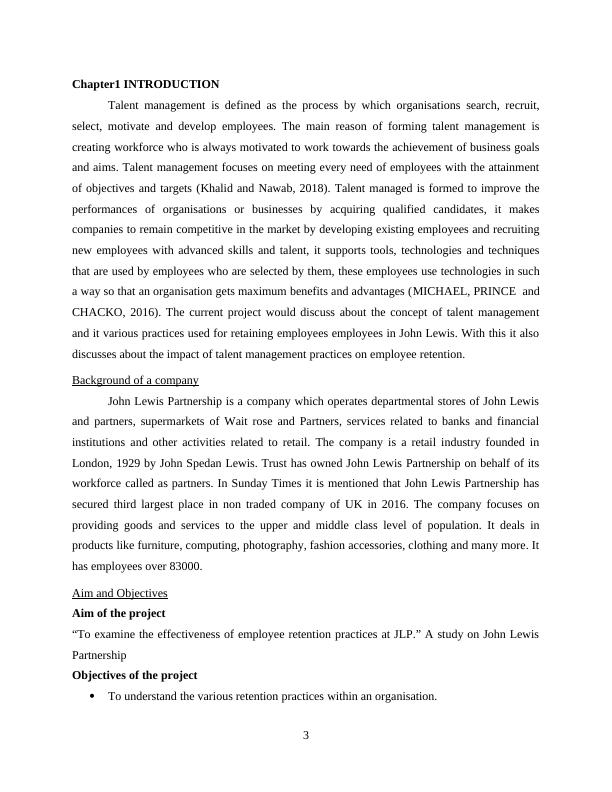
To understand the impact of retention practices on the performance of John Lewis
Partnership.
To recommend ways through which John Lewis Partnership can retain employees for
longer time period.
Rationale of the project
The main purpose of doing this project is to understand the impact of talent management
practices on employee retention. This project would clearly explain the importance of talent
management practices to keep employees within an organisation. The project would help in
achieving two kind of perspectives: personal perspective and professional perspective.
According to the personal, this accommodates in understanding operations which are useful and
important in growth of candidates. The another benefit with this project is it would help in
understanding the practices of talent management in retention of employees. According to the
professional perspective, the biggest benefit is learning application of talent management
practices in organisations with operating tasks effectively and efficiently. In future it would help
me in creating good profession.
4
Partnership.
To recommend ways through which John Lewis Partnership can retain employees for
longer time period.
Rationale of the project
The main purpose of doing this project is to understand the impact of talent management
practices on employee retention. This project would clearly explain the importance of talent
management practices to keep employees within an organisation. The project would help in
achieving two kind of perspectives: personal perspective and professional perspective.
According to the personal, this accommodates in understanding operations which are useful and
important in growth of candidates. The another benefit with this project is it would help in
understanding the practices of talent management in retention of employees. According to the
professional perspective, the biggest benefit is learning application of talent management
practices in organisations with operating tasks effectively and efficiently. In future it would help
me in creating good profession.
4
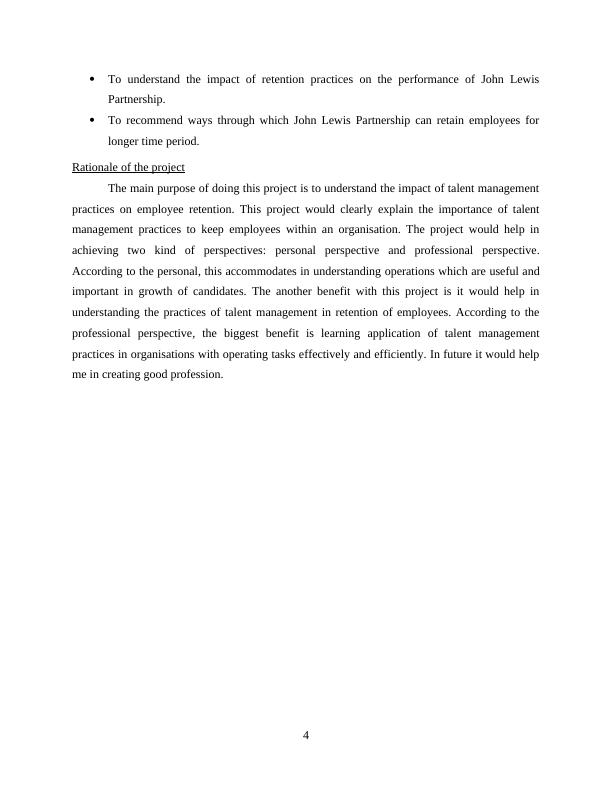
Chapter 2 LITERATURE REVIEW
Literature review is a chapter which assists researcher to gather data from secondary
sources like magazines, books and journal articles. The data which is collected from sources of
secondary are not first hand data, these data are used to conduct and gain in-depth knowledge.
Various retention practices within an organisation
According to Florentine (2019), employee retention is a concerned issue for organisations
and companies because they have to compete with their competitors to acquire talented and
qualified employees. If employee leaves a firm then they have to pay hard costs like employee
turnover cost and soft costs like reduction in productivity, lowering engagement, costs of training
and so on. Organisations which constantly focus on employee retention on time with great
investment get great pay off in future. Increase in productivity, improvement in performance,
improvement in efficiency of work and many more. For this organisations adopt various
practices for retention of employees, some of them are explained below:
Retention starts from beginning: Retention is a process which starts from the starting stage
of application process of candidates (Kuligowski, 2021). In the screening process only
organisation identifies what type of strategy and culture they want to create and adopt in the
environment of workplace and then search for those candidates who would be comfortable in
working with such type of environment. When employees know about the culture of
organisations at primary stage, it reduces confusion and chaos in future and decreases situations
where employees think to leave companies.
Identification of candidates: Organisations select candidates who have worked in prior jobs
for a longer period of time, contributed in ups and downs of a company. If such employees are
selected in an organisation then it automatically reduces the chances of leaving an organisation in
future (Alola and Alafeshat, 2021). Job hoppers are the people who continuously switch from
one company to another and retaining such kind of employees are difficult, so identifying
background of employees before selecting is adopted by organisation for retention of employees
in future and mitigate the risk of employee leaving the company.
Providing on the job education: As per Florentine (2019), organisations arrange and
organise many development programs time to time for their employees so that they can develop
in their career and get more efficient in their work, jobs and responsibilities. When employees
5
Literature review is a chapter which assists researcher to gather data from secondary
sources like magazines, books and journal articles. The data which is collected from sources of
secondary are not first hand data, these data are used to conduct and gain in-depth knowledge.
Various retention practices within an organisation
According to Florentine (2019), employee retention is a concerned issue for organisations
and companies because they have to compete with their competitors to acquire talented and
qualified employees. If employee leaves a firm then they have to pay hard costs like employee
turnover cost and soft costs like reduction in productivity, lowering engagement, costs of training
and so on. Organisations which constantly focus on employee retention on time with great
investment get great pay off in future. Increase in productivity, improvement in performance,
improvement in efficiency of work and many more. For this organisations adopt various
practices for retention of employees, some of them are explained below:
Retention starts from beginning: Retention is a process which starts from the starting stage
of application process of candidates (Kuligowski, 2021). In the screening process only
organisation identifies what type of strategy and culture they want to create and adopt in the
environment of workplace and then search for those candidates who would be comfortable in
working with such type of environment. When employees know about the culture of
organisations at primary stage, it reduces confusion and chaos in future and decreases situations
where employees think to leave companies.
Identification of candidates: Organisations select candidates who have worked in prior jobs
for a longer period of time, contributed in ups and downs of a company. If such employees are
selected in an organisation then it automatically reduces the chances of leaving an organisation in
future (Alola and Alafeshat, 2021). Job hoppers are the people who continuously switch from
one company to another and retaining such kind of employees are difficult, so identifying
background of employees before selecting is adopted by organisation for retention of employees
in future and mitigate the risk of employee leaving the company.
Providing on the job education: As per Florentine (2019), organisations arrange and
organise many development programs time to time for their employees so that they can develop
in their career and get more efficient in their work, jobs and responsibilities. When employees
5
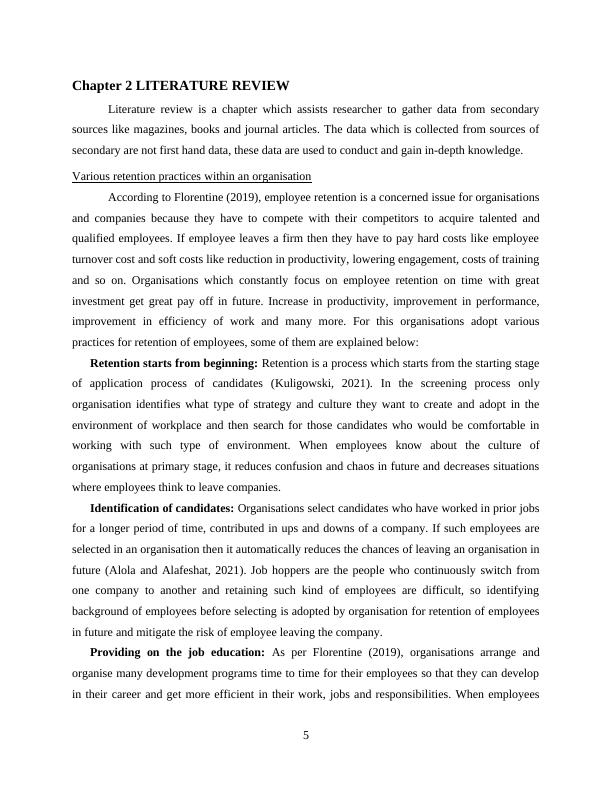
get proper education related to their jobs and responsibilities their chances to get promotion
increases and take company towards success. Employee education and development go hand in
hand with promotions and lead company to retain employees for maximum time. Trainings in
corporates uses advance techniques and technologies to improve skills of employees and this
help in retention of employees because employees feel that they are valued and company is
doing investment to increase their skills (Chawla, 2021).
Giving proper benefits time to time: Different perks and benefits play an important role in
making employees engaged, healthy and joyful in an organisation. Benefits like coverage for
healthcare, sick leaves that are paid, providing stock options, financial benefits all these are
given to employee who are performing exceptionally well in the allotted time period. These all
benefits motivate employees to stay in the same organisation and work harder. These leave
policies, good pay, and flexibility in working hours make employees to think they are being
valued in organisation for their contribution and they decide to stay in the same venture for a
longer period of time.
Impact of retention practices on the performance of John Lewis Partnership
According to Ramirez (2020), different retention practices adopted by John Lewis
Partnership assist in doing activities effectively and efficiently because every activity is the
responsibility of employees. Employees are the most importance resource to take out different
activities within a company. So John Lewis Partnership invest time and money in different
retention practices to retain employees with them for maximum time. Retention practices have
positive impact on the performance of John Lewis Partnership because it reduces various costs
like soft costs and hard costs like training and turnover cost. Some other advantages with the
impact of retention practices on performance are explained below:
Decreases hassle of turnover: Turnover of employees are very natural in organisations but
when it increases in a large number then it becomes crucial problem. As per the view presented
Mangal (2021), it creates a situation where John Lewis Partnership has to search new employee
for vacant job which increases the wastage of time but by focusing on retention practices it can
save time for other useful activities like production, marketing and many more and ultimately
increase the performance of organisation.
Reduces development time: According to Ramirez (2020), employees leaving a company
consume a lot of time because finding new qualified employees is not an easy task and giving
6
increases and take company towards success. Employee education and development go hand in
hand with promotions and lead company to retain employees for maximum time. Trainings in
corporates uses advance techniques and technologies to improve skills of employees and this
help in retention of employees because employees feel that they are valued and company is
doing investment to increase their skills (Chawla, 2021).
Giving proper benefits time to time: Different perks and benefits play an important role in
making employees engaged, healthy and joyful in an organisation. Benefits like coverage for
healthcare, sick leaves that are paid, providing stock options, financial benefits all these are
given to employee who are performing exceptionally well in the allotted time period. These all
benefits motivate employees to stay in the same organisation and work harder. These leave
policies, good pay, and flexibility in working hours make employees to think they are being
valued in organisation for their contribution and they decide to stay in the same venture for a
longer period of time.
Impact of retention practices on the performance of John Lewis Partnership
According to Ramirez (2020), different retention practices adopted by John Lewis
Partnership assist in doing activities effectively and efficiently because every activity is the
responsibility of employees. Employees are the most importance resource to take out different
activities within a company. So John Lewis Partnership invest time and money in different
retention practices to retain employees with them for maximum time. Retention practices have
positive impact on the performance of John Lewis Partnership because it reduces various costs
like soft costs and hard costs like training and turnover cost. Some other advantages with the
impact of retention practices on performance are explained below:
Decreases hassle of turnover: Turnover of employees are very natural in organisations but
when it increases in a large number then it becomes crucial problem. As per the view presented
Mangal (2021), it creates a situation where John Lewis Partnership has to search new employee
for vacant job which increases the wastage of time but by focusing on retention practices it can
save time for other useful activities like production, marketing and many more and ultimately
increase the performance of organisation.
Reduces development time: According to Ramirez (2020), employees leaving a company
consume a lot of time because finding new qualified employees is not an easy task and giving
6
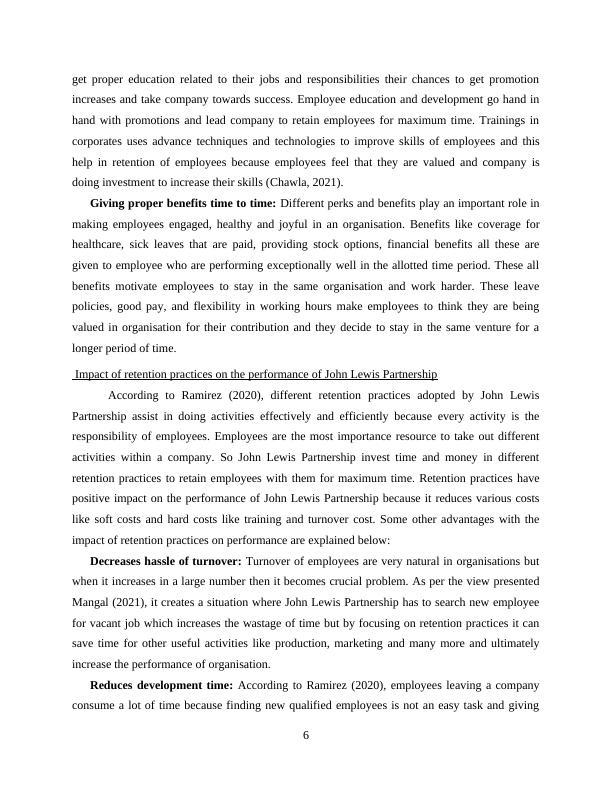
End of preview
Want to access all the pages? Upload your documents or become a member.
Related Documents
Impact of Staff Motivation Schemes on Employee Retention: A Study on Boots plclg...
|28
|5753
|128
Current Trends and Challenges Impacting Talent Management Strategies: A Study on Unilever in UK Retail Sectorlg...
|40
|9012
|303
The Impact of Rewards and Incentives on Motivation and Retention of Employees in the UK Retail Industrylg...
|39
|7829
|384
Impact of talent management in retaining employee and enhancing motivation in UK retail industrylg...
|26
|6570
|147
Role of talent management in culture changelg...
|27
|6408
|63
Impact of Globalisation on Corporate Structures of John Lewis & Partnerslg...
|26
|6369
|63
